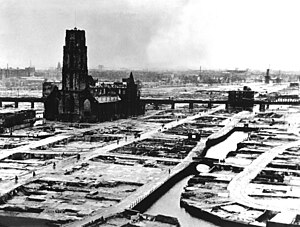Rotterdam Blitz
| The Rotterdam Blitz | |||||||
|---|---|---|---|---|---|---|---|
| Part of the invasion of the Netherlands | |||||||
 Rotterdam's city centre after the bombing. The heavily damaged (now restored) St. Lawrence church stands out as the only remaining building reminiscent of Rotterdam's medieval architecture. |
|||||||
|
|||||||
| Belligerents | |||||||
|
|
|
||||||
| Commanders and leaders | |||||||
|
|
|||||||
| Units involved | |||||||
|
Luchtvaartafdeling (LVA) Marine Luchtvaartdienst (MLD) |
Luftflotte 2 | ||||||
| Strength | |||||||
| No remaining operational fighter aircraft | ~80 aircraft directly involved ~700 involved in concurrent operations |
||||||
| Casualties and losses | |||||||
| 884 civilians killed LVA and MLD virtually destroyed. |
None | ||||||
The Rotterdam Blitz was the aerial bombardment of Rotterdam by the Luftwaffe (German air force) on 14 May 1940, during the German invasion of the Netherlands in World War II. The objective was to support the German troops fighting in the city, break Dutch resistance and force the Dutch to surrender. Even though preceding negotiations resulted in a ceasefire, the bombardment took place nonetheless, in conditions which remain controversial, and destroyed almost the entire historic city centre, killing nearly 900 people and making 85,000 others homeless.
The psychological and physical success of the raid, from the German perspective, led the Oberkommando der Luftwaffe (OKL) to threaten to destroy the city of Utrecht if the Dutch Government did not surrender. The Dutch capitulated early the next morning.
The Netherlands during the Second World War was strategically lodged between Great Britain and Germany, making it an ideal prospective German air and naval "base" during Operation Sea Lion, the planned invasion of the British Isles that was to follow the forthcoming aerial Battle of Britain. The Netherlands had firmly opted for neutrality throughout the First World War and had planned to do the same for the Second World War. It most notably refused to accept armaments from France, making the case that they wanted no association with either side. While armament production was slightly increased after the invasion of Denmark in April 1940, the Netherlands possessed 35 modern wheeled armoured fighting vehicles, no tracked armoured fighting vehicles, 135 aircraft and 280,000 soldiers, while Germany had 159 tanks, 1,200 modern aircraft, and around 150,000 soldiers at their disposal for the Dutch theatre alone.
...
Wikipedia
